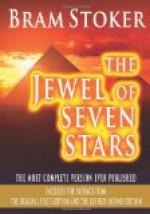“I knew well that such a figure was not wrought to pleasantry; and that to brave it was no child’s play. The dead Arab at my feet was proof of what could be done! So I examined again along the wall; and found here and there chippings as if someone had been tapping with a heavy hammer. This then had been what happened: The grave-robber, more expert at his work than we had been, and suspecting the presence of a hidden serdab, had made essay to find it. He had struck the spring by chance; had released the avenging ‘Treasurer’, as the Arabian writer designated him. The issue spoke for itself. I got a piece of wood, and, standing at a safe distance, pressed with the end of it upon the star.
“Instantly the stone flew back. The hidden figure within darted forward and thrust out its lance. Then it rose up and disappeared. I thought I might now safely press on the seven stars; and did so. Again the stone rolled back; and the ‘Treasurer’ flashed by to his hidden lair.
“I repeated both experiments several times; with always the same result. I should have liked to examine the mechanism of that figure of such malignant mobility; but it was not possible without such tools as could not easily be had. It might be necessary to cut into a whole section of the rock. Some day I hope to go back, properly equipped, and attempt it.
“Perhaps you do not know that the entrance to a serdab is almost always very narrow; sometimes a hand can hardly be inserted. Two things I learned from this serdab. The first was that the lamps, if lamps at all there had been, could not have been of large size; and secondly, that they would be in some way associated with Hathor, whose symbol, the hawk in a square with the right top corner forming a smaller square, was cut in relief on the wall within, and coloured the bright vermilion which we had found on the Stele. Hathor is the goddess who in Egyptian mythology answers to Venus of the Greeks, in as far as she is the presiding deity of beauty and pleasure. In the Egyptian mythology, however, each God has many forms; and in some aspects Hathor has to do with the idea of resurrection. There are seven forms or variants of the Goddess; why should not these correspond in some way to the seven lamps! That there had been such lamps, I was convinced. The first grave-robber had met his death; the second had found the contents of the serdab. The first attempt had been made years since; the state of the body proved this. I had no clue to the second attempt. It might have been long ago; or it might have been recently. If, however, others had been to the tomb, it was probable that the lamps had been taken long ago. Well! all the more difficult would be my search; for undertaken it must be!
“That was nearly three years ago; and for all that time I have been like the man in the Arabian Nights, seeking old lamps, not for new, but for cash. I dared not say what I was looking for, or attempt to give any description; for such would have defeated my purpose. But I had in my own mind at the start a vague idea of what I must find. In process of time this grew more and more clear; till at last I almost overshot my mark by searching for something which might have been wrong.




